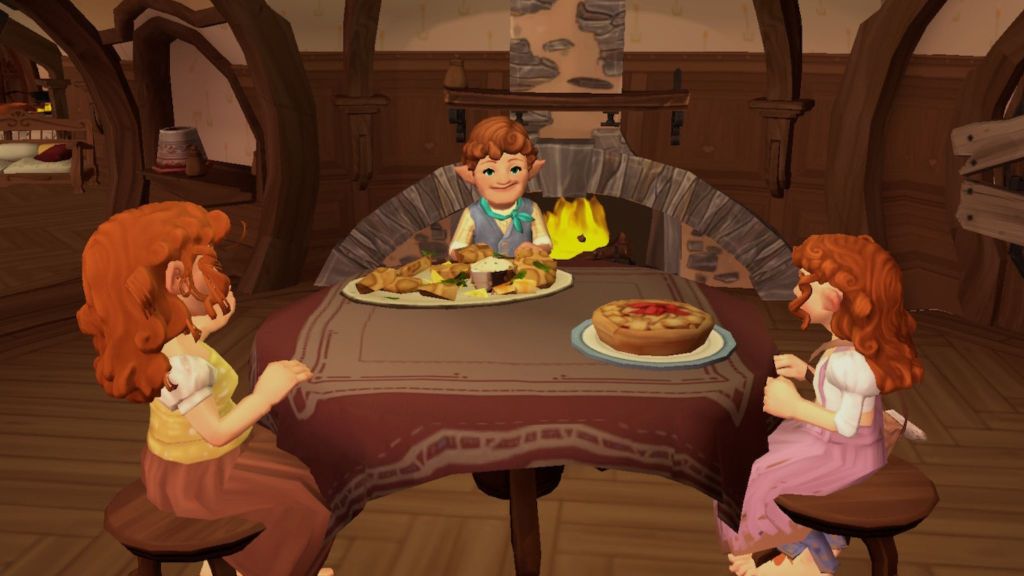One of the most anticipated cozy games of the year is Weta Workshop’s Tales of the Shire: A Lord of the Rings Game. This title lets players step into Tolkien’s Shire to live their own Hobbit life. The gameplay loop is full of farming, fellowship, and food – the pillars of the Shire. But translating a massive IP into a new style of game is a big challenge, and Weta Workshop wound up taking longer than expected to get the recipe just right. After a few delays, Tales of the Shire is ready for its big adventure starting July 29th.
Videos by ComicBook.com
Recently, I had the pleasure of speaking with Tales of the Shire‘s Creative Director, Stephen Lambert, and Lead VFX Artist, Simon Baker. During our discussion, we talked about what went into translating the Shire of the films to the version we see in the game, how those beautiful Shared Meals came to be, and more.
Right off the bat, I asked the Weta team about the inspiration behind making a cozy Lord of the Rings game set in the Shire.
“I mean, it’s one of those ideas where you when you give the description of it, it just sounds just so perfect,” Baker told me, adding, “Why hasn’t someone already made this?”
The idea was born during the lockdown era of the COVID-19 pandemic, and the isolation of the period helped shape Tales of the Shire.
“At the time, we’re in the depths of lockdown and COVID and everything, so you could see how people were just kind of craving something that was an escape… that was a bit more easygoing and idyllic, and that seemed like a perfect match, really, that you could escape your apartment or whatever it was and go live in this cozy Shire,” Baker shared. He and Lambert agree that the desire for community connection are a large part of what led to the desire to make a cozy game set in the Shire.

Of course, you can’t set a game in the Shire without being truly steeped in Tolkien lore. Weta Workshop is a great fit for this due to their previous work on the Hobbit movies. Even so, Baker notes that working with an IP like The Lord of the Rings “is always going to be daunting,” while adding “you’ve always got to take great care that you’re treating the material you’re working with with care and love.”
That care was clear in how both Simon and Stephen spoke about Weta’s work on the game. The team took the approach of “trying to weave in as much connections to the world as possible while also keeping in mind that we’re really focusing no the Shire, and it’s got a little community that is kind of protected from the wider craziness of Middle Earth.” He went on to say that the team at Weta “often talk about the idea of Hobbit-sized problems for a Hobbit-sized world.”
Lambert added that Weta’s history working with Middle-earth helped them craft Bywater for Tales of the Shire. Specifically, Weta worked to pull in characters and details from Tolkien and connect them to the story they build in the game. That means there will be plenty of Easter Eggs for Tolkien fans to spot. I asked Simon and Stephen to share a few they’re hoping we’ll notice.
“Certainly the Cotton family is pretty key to the books,” Baker said. “So having their history and kind of a little bit of backstory” are his “favorite bits and pieces.”
Weta wanted to bring in as many canon Tolkien characters who live in Bywater Village as possible. But it was tricky, as they “didn’t want to stitch [themselves] int a corner or make something that was going to cause future narrative problems.” So, characters were carefully chosen to “feed that core narrative” and “feed little nuggets to what might be in those characters’ histories in the books, a little bit of backstory behind them.” Weta’s resident Tolkien scholar helped make sure the characters and world stayed true to Tolkien’s texts, meaning there are plenty of details for fans to tease out as they play.

When it comes to Easter eggs, Lambert wants players to really notice the details in the decoration system.
“There’s pictures and things like that that you can unlock to put on the wall, they’re all just, Steve’s concept art and key images that we’ve been able to bring into the game,” he said.
So as you’re decorating your Hobbit hole, be sure to take an extra close look your options for some behind-the-scenes glimpses into the making of Tales of the Shire.
To really create a Bywater that feels authentic for Tolkien fans, Weta went beyond the books. The team also “looked at Tolkien himself and where he was and the things that he experiences, places he experienced when he was writing these books,” according to Lambert.”Where he lived in the UK… the flow of the sun direction at that part of the world and the different seasons.” He added that the team wanted to “look for inspiration in the places that Tolkien himself would have looked for inspiration as well.”
This came down even to what you can grow and gather in Tales of the Shire. One of the game’s technical artists was set “on a path of basically going on a real big deep dive into look at all of the different plant life that [Weta] wanted to include in the game, and that refers back to looking at the types of plant life that Tolkien himself would have experienced where he was from,” Lambert said. Taking inspiration in this way leads to some unique forgeables in the game like edible Nasturian flowers alongside more familiar fare like Blackberries.
Of course, these forageables and farming plants ultimately had to feed into the game’s other systems, including its robust cooking and Shared Meal mechanics. “Ultimately, food is kind of the core of the game, the core of Hobbit life,” Baker told me. “It’s what you spend most of your time kind of preparing for and making during the day, and we wanted to make it feel as broad as possible because it’s the main feature of your life.” That meant thinking “as broadly as possible to create this massive list of things you could potentially cook and mix together.”
Lambert went on to reveal that the Shared Meal system started with inspiration from Hobbit parties like Bilbo’s infamous birthday party. It got a bit scaled back over time, but remains “the culmination of all the other systems of the game, kind of your overarching goal of everything that you do in the world, like fishing, foraging, cooking, and developing relationships with the other townsfolk.”

As a pillar of the game, the meals were “quite a design challenge” for Weta. “Food, ultimately, it’s about taste. And how do you convey a sense of pleasure and taste to something that’s subjective, but also how you can’t express whether or not you’ve put too much salt in it, because you’ll never know,” Baker explained. Thankfully, Weta had a secret weapon for this challenge. “One of our artists was previously a professional chef, so we relied on him a lot for plating up the meals in terms of how he arranged things on the plates and what those meals were, what the cooking processes were, and things like that.”
In my opinion, Tales of the Shire‘s cooking system is one of the places where the game shines, so this attention to detail certainly comes through. To hear Lambert describe it, “the minute Nick put together these plates of food, and they looked like professional magazine photos of these amazing meals, automatically our brains were like, this has got to be bigger than what we’ve even got now because it looks just so lovely.”
The food, and the Shire itself, do indeed look lovely in the virtual Hobbit world that Weta Workshop has crafted in Tales of the Shire. Before we wrapped up our conversation, I asked for any final tidbits for gamers to look forward to. This naturally brought us to Ladle the Duck, a charming friend to Bywater’s only non-Hobbit resident, Nefi the Dwarf. Ladle is just one of many charming animal friends players will encounter as they explore Bywater and help it to become a real village.
Tales of the Shire releases on July 29th for Nintendo Switch, Xbox Series X|S, PS5, and PC via Steam. It costs $34.99 on all platforms.








